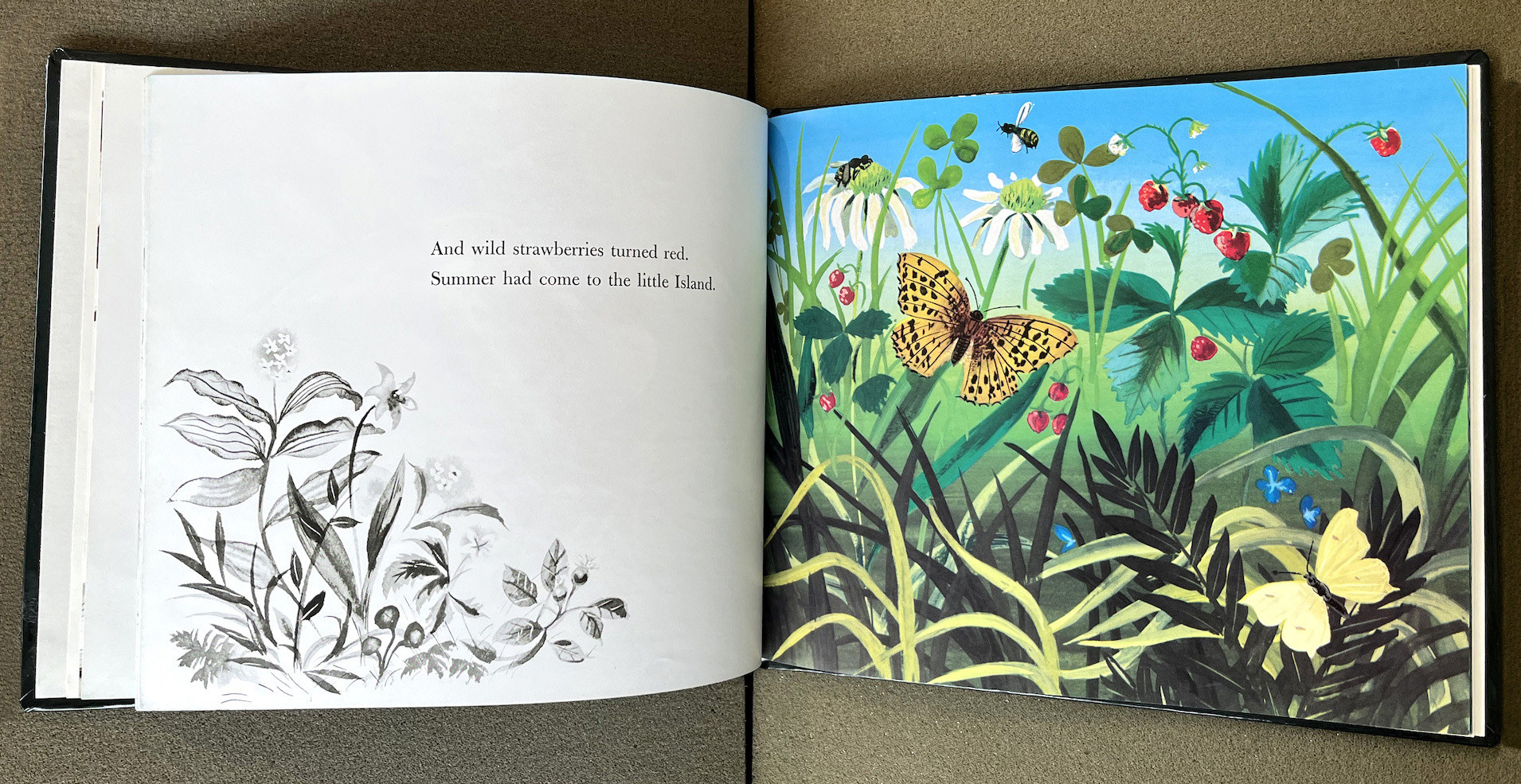
Margaret Wise Brown’s Celebration of the Seasons
While Margaret Wise Brown may not be a household name, her work graces the bookshelves of most children’s libraries, including those of the Henrietta Hochschild Collection of Children’s Books. Goodnight Moon, published in 1947, is undoubtedly Brown’s best-known work, offering an enchanting meditation on bedtime (Marcus, 1997). “In the great green room,” it reads, “there was a telephone. And a red balloon. And a picture of a cow jumping over the moon.” In sharp contrast to the fairy tales popular in the early twentieth century, Goodnight Moon and many of Brown’s over 100 published picture books focused on the quiet experiences of everyday life consistent with an emerging theory in children’s literature that captivated Brown—the Here and Now approach.
Here and Now
The Here and Now approach, an educational theory developed at the Bank Street Experimental School in New York, argued that children’s books should focus not on fantasy and faraway lands, but on the objects and experiences of everyday life (Sprague Mitchell, 1921). Through interactions with students at Bank Street, Brown found truth in these theories. She observed that children gravitated toward familiar topics, from the humble, like toys and mittens, to the more public and boisterous, like dump trucks and trains. Given Bank Street’s New York City location, many early books focused on the experiences of the city-dweller. But Brown, having grown up spending summers frolicking in the woods near her home and vacationing at the seashore, was tuned into the poetry of the natural world (Marcus, 2001). Convinced that all children, even those in cities, noticed the rhythms and wonders of nature, Brown created lyrical stories for children about relatable topics like birds, insects, and the weather. The seasons and their omnipresence particularly interested Brown. The Hochschild Collection holds several of Brown’s works that celebrate the seasons and their impact on a child’s daily life.
The Children’s Year
Brown’s 1937 book The Children’s Year illustrated by Rojan, is a classic example of a Here and Now story through the lens of the shifting seasons. Brown devotes each page to a month of the year and the beauty that accompanies each. With a particular focus on the objects of childhood, including kites, school books, and Easter eggs, the story maintains a connection to the Here and Now approach while subtly expanding its focus to encompass natural phenomena. The book celebrates the sensory qualities of the natural world. Rojan’s pictures offer a soft tactility with their layers of pencil shading while Brown’s words celebrate the sounds and smells of the seasons. Reading more as poetry than narrative, Brown speaks of burning rocks, the soft murmur of insects, and summers that smell like mint and roses in this celebration of the magic in the mundane.
Two Little Gardeners
Brown delivered another seasonal celebration in her 1951 book, Two Little Gardeners, written in collaboration with Edith Thatcher Hurd and illustrated by Gertrude Elliot. Like many of Brown’s Here and Now books, Two Little Gardeners is relatively free of plot and instead organically follows the flow of the seasons through the lives of two children tending a backyard vegetable garden. Tiny moments of transformation and growth that a fairy tale would overlook become the center of the narrative, like the growth of summer weeds or the shift in color as vegetables ripen on the vine. While not every child has the opportunity to tend a garden, the poetic text encourages readers to observe how the seasons work magic in their own backyard with a renewed sense of curiosity and watchful wonder.
The Little Island
While focused not on humans but on a curious kitten, Brown’s 1946 book The Little Island, illustrated by Leonard Weisgard, offers a philosophical tale about the interconnectedness of the natural world. The book begins and ends with sensory observations of the quiet changes that occur as the seasons pass on the island. A blossoming pear tree signals spring, ripe strawberries announce summer, and snow that comes “like a great quiet secret in the night” blankets the little island in winter slumber. The more plot-heavy interlude in the middle of the narrative when the kitten arrives on the island feels secondary to the sensory moments of the book. The kitten’s final discovery that the island, despite its isolated appearance, is connected to the rest of the land reveals Brown’s belief, indeed hope, that each child, however far from the oceans and gardens of her books, remains connected to the natural world.
Despite the fact that nature was a smaller part of urban children’s vernacular in a rapidly modernizing twentieth century, Margaret Wise Brown dedicated much of her work to a celebration of natural spaces. Many of her books use the seasons as a bridge between a child’s daily life and the larger natural world. The Margaret Wise Brown books in the Hochschild Collection bear witness to a fascinating period in children’s literature and are excellent resources for students and researchers interested in illustration, literature, and educational theories.
For more information, please contact Curator of Rare Books Cassie Brand.
Danielle Ridolfi is a master’s student in the Illustration and Visual Culture Program at Washington University.
Sources Cited
Marcus, Leonard. The Making of Goodnight Moon: A 50th Anniversary Retrospective. New York, Harper Trophy, 1997.
Marcus, Leonard. Margaret Wise Brown: Awakened by the Moon. New York: Perennial, 2001.
Sprague Mitchell, Lucy. Here and Now Storybook. New York, E.P. Dutton & Company, 1921.






